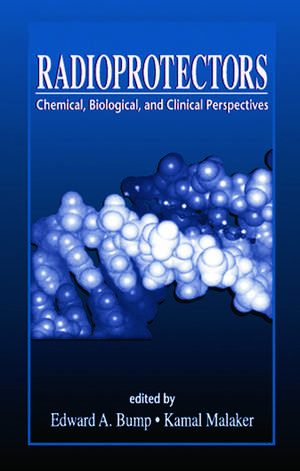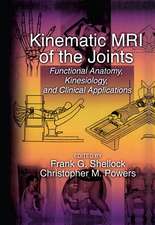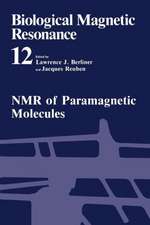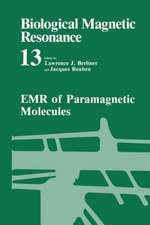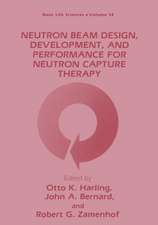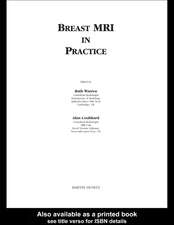Radioprotectors: Chemical, Biological, and Clinical Perspectives
Autor Edward A. Bump, Kamal Malakeren Limba Engleză Hardback – 29 dec 1997
Radiation biologists and oncologists, cancer researchers, and toxicologists will benefit from the findings discussed and strategies for future research.
Preț: 1621.71 lei
Preț vechi: 1707.07 lei
-5% Nou
Puncte Express: 2433
Preț estimativ în valută:
310.32€ • 324.66$ • 257.78£
310.32€ • 324.66$ • 257.78£
Carte tipărită la comandă
Livrare economică 02-16 aprilie
Preluare comenzi: 021 569.72.76
Specificații
ISBN-13: 9780849347566
ISBN-10: 0849347564
Pagini: 448
Ilustrații: 58 tables and 52 equations
Dimensiuni: 156 x 234 x 27 mm
Greutate: 0.98 kg
Ediția:1
Editura: Taylor & Francis
Colecția CRC Press
Locul publicării:Oxford, United Kingdom
ISBN-10: 0849347564
Pagini: 448
Ilustrații: 58 tables and 52 equations
Dimensiuni: 156 x 234 x 27 mm
Greutate: 0.98 kg
Ediția:1
Editura: Taylor & Francis
Colecția CRC Press
Locul publicării:Oxford, United Kingdom
Public țintă
ProfessionalCuprins
SECTION I -- CHEMICAL ASPECTS OF RADIOPROTECTION -- Introduction /Edward A. Bump -- Chapter 1 -- History of Radioprotector Development /William O. Foye -- Chapter 2 -- The Mechanisms of Radiation Protection by Non-Protein Sulfhydryls: Glutathione, Cysteine, and Cysteamine /Cameron J. Koch -- Chapter 3 -- Aminothiols /David Murray -- Chapter 4 -- Stable Free Radicals as Radiation Protectors /Stephen M. Hahn, C. Murali Krishna, and James B. Mitchell -- Chapter 5 -- Radioprotection by Superoxide Dismutase /Radha M. Das -- Chapter 6 -- DNA-Binding Bibenzimidazoles as Radioprotectors /Roger F. Martin -- Chapter 7 -- Protection against Radiation Damage to DNA Bases /Ali Laayoun, Jean Lhomme, Maurice Berger, and Jean Cadet -- SECTION II -- BIOLOGICAL PERSPECTIVES OF RADIOPROTECTION -- Introduction /William F. Blakely, Joseph F. Weiss, and Edward A. Bump -- Chapter 8 -- Eicosanoid-Induced Radioprotection and Chemoprotection: Laboratory Studies and Clinical Applications /Wayne R. Hanson -- Chapter 9 -- Immunomodulators and Cytokines: Their Use in the Mitigation of Radiation-Induced Hemopoietic Injury /Myra L. Patchen -- Chapter 10 -- Modulation of the Radiation Response by Cytokines /Ruth Neta -- Chapter 11 -- Radiation-Induced Apoptosis in Lymphoid Cells: Induction, Prevention, and Molecular Mechanisms /Narayani Ramakrishnan, John F. Kalinich, and David E. McClain -- Chapter 12 -- Modulation of Radiation-Induced Apoptosis /S. T. Palayoor, Ruth E. Langley, C. Norman Coleman, and Edward A. Bump -- Chapter 13 -- Chemoprevention with WR-2721 and Its Metabolites /Jeffrey S. Murley and David J. Grdina -- SECTION III RADIOPROTECTION OF NORMAL TISSUES -- Introduction /Elizabeth L. Travis -- Chapter 14 -- Protection against Radiation Damage to Vascular Tissues /Susan J. Braunhut -- Chapter 15 -- Radiation Protection in the Developing Central Nervous System: Investigation of a Biological Approach /Phyllis J. Mullenix -- Chapter 16 -- Clinical Experience with Radioprotectors /Kamal Malaker -- INDEX.
Notă biografică
Edward A. Bump, Ph.D., is associate professor of radiation therapy at the Joint Center for Radiation Therapy, Harvard Medical School and at the Dana-Farber Cancer Institute, Boston, MA. Dr. Bump received his B.S. in biochemistry from Cornell University in 1970. He obtained his Ph.D. in biochemistry from Oregon State University in 1975, under the direction of Dr. Donald Reed, and completed postdoctoral fellowships under the direction of Dr. Daniel Atkinson (UCLA) and Drs. Robert Fahey and Jerry Schneider (UCSD) prior to joining the laboratory of Dr. J. Martin Brown in the Department of Radiology at Stanford University, as a research associate. He was appointed assistant professor at the Joint Center for Radiation Therapy, Harvard Medical School, in 1985, and was appointed associate professor in 1995. Dr. Bump’s graduate and postdoctoral research dealt with the role of thiols in regulation of cellular metabolism, and in the response of tumor cells to the anticancer agent, procarbazine. At Stanford University, he studied the role of thiols, and particularly glutathione, in the radiation response of mammalian cells. Most recently his research has been aimed at developing new strategies for chemical or biochemical modification of the biological effects of ionizing radiation. He has published approximately 50 papers, including several comprehensive reviews on modification of the radiation response. Dr. Bump is a member of the Radiation Research Society, the Oxygen Society, Free Radical Research International, the American Association of Cancer Research, The American Society of Therapeutic Radiation Oncologists, The American Association for the Advancement of Science, and the American Society of Biochemistry and Molecular Biology. Kamal Malaker, M.D., Ph.D., graduated in medicine from the University of Calcutta, India. He began his specialty training in radiotherapy and clinical oncology under Drs. Frank Ellis and Chris Paine in Oxford, England. He completed his training at The Hammersmith Hospital and The Royal Postgraduate Medical School of London University, U.K., where he worked as Senior Registrar and Tutor in radiotherapy and clinical oncology for several years. Having moved to Canada in 1977, he joined the Manitoba Cancer Treatment and Research Foundation as a staff radiation oncologist, eventually becoming the Director of radiation oncology at the the Foundation. He was also head of radiation oncology at the University of Manitoba, Canada. Dr. Malaker has maintained a lifelong interest in research on radiosensitizers and radioprotectors, on which he has authored several papers. This research continues at the Joint Center at Harvard. During his career, Dr. Malaker has maintained a strong interest in education, training, and development of radiotherapy services in developing countries and is actively involved in various programs initiated by international organizations such as WHO and UICC.
Descriere
It is essential to minimize damage to normal tissues during radiation therapy and many strategies have been employed in finding the best methods for radioprotection
